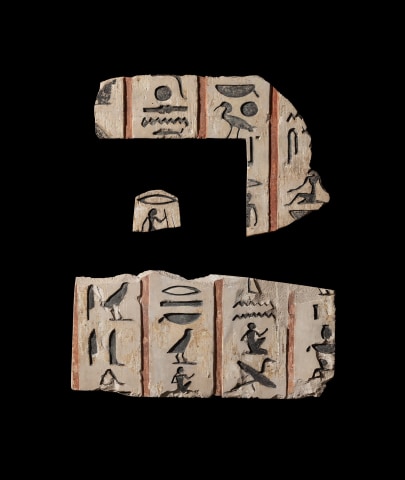Three sections of wall relief with lines of sunken hieroglyphic
text in black, the column dividers in red. The fragments
come from the tomb of Bakenrenef, vizier of Pharaoh
Psamtik I. The smallest of the fragments might not be from
the same wall section as the other two. Restored from
fragments, with some touching in and repaint.
Bakenrenef played a major role in the early 26th Dynasty. He
built an imposing tomb into the steep rocks at the eastern desert
edge of Saqqara; it is considered the largest and finest of the
period. However, the interior was reused for other burials during
the 30th Dynasty and therefore includes nine intrusive burial
shafts. Because of the poor quality of bedrock at Saqqara, the
tombs had a facade made from Tura limestone blocks. The tomb
was extravagantly inscribed with religious texts, and has
remarkably few remains of figural decoration. Many relief
sections are now in the museums of Cairo, Berlin, Munich,
Chicago and others, whilst Bakenrenef ’s limestone sarcophagus
is in the National Archaeological Museum of Florence in Italy.
Provenance
From the tomb of Bakenrenef, Vizier of Psamtik (664-610 BC), discovered at the beginning of the 19th century
at Saqqara by Carl Richard Lepsius (1810-1884)
Hans Becker (1914-2004), Oberursel, Germany
Robert Kime (1946-2022), London, UK; acquired 21st
April 2005
Literature
A large section of wall relief from the tomb of Bakenrenef was acquired by the Metropolitan Museum, New York, USA in 1911, accession number 11.150.50c. It was purchased from Maurice Nahman, Cairo, Egypt, in 1908.
